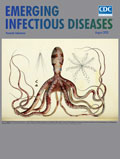
Volume 26, Number 8—August 2020
Dispatch
Atypical Pathogenicity of Avian Influenza (H3N1) Virus Involved in Outbreak, Belgium, 2019
Mieke Steensels , Philippe Gelaude, Steven Van Borm, Thierry Van Den Berg, Mickaël Cargnel, Virginie Roupie, Fabienne Rauw, and Bénédicte Lambrecht
, Philippe Gelaude, Steven Van Borm, Thierry Van Den Berg, Mickaël Cargnel, Virginie Roupie, Fabienne Rauw, and Bénédicte Lambrecht
Abstract
In 2019, an outbreak of avian influenza (H3N1) virus infection occurred among commercial poultry in Belgium. Full-genome phylogenetic analysis indicated a wild bird origin rather than recent circulation among poultry. Although classified as a nonnotifiable avian influenza virus, it was associated with reproductive tropism and substantial mortality in the field.
Avian influenza is a highly contagious viral disease of poultry, able to infect all species of birds (1). Of the 2 existing pathotypes, low pathogenicity avian influenza (LPAI) and highly pathogenic avian influenza (HPAI), infection with LPAI virus is mostly undetected in a flock but can cause some respiratory signs, egg drop, lethargy, and limited mortality (2,3). Avian influenza H5/H7 subtypes are all notifiable to the authorities in Europe because adaptive mutations can influence the polybasic nature of the hemagglutinin (HA) cleavage site, resulting in HPAI emergence (4). For all other avian influenza subtypes, only those with an intravenous pathogenicity index (IVPI) >1.2 must be reported (5).






















.png)











No hay comentarios:
Publicar un comentario